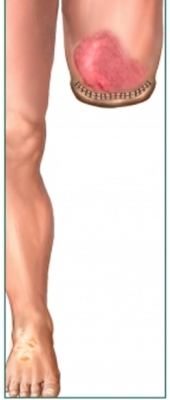Amputation of the leg above the knee – Transfemoralynaya amputation
Description amputation above the knee
Amputation above the knee – surgery to surgical removal of the leg above the knee.

Reasons for amputation above the knee
Ablation, usually, done for one of the following reasons::
- Poor blood flow in the extremities, cause tissue damage or severe pain;
- Severe infection;
- Trauma or injury;
- Tumor;
- Congenital diseases (eg, the presence of a limb, which is not formed properly).
Possible complications of leg amputation above the knee
If you plan to make a leg amputation, you need to know about possible complications, which may include:
- Nezazhivlenie wounds;
- Infection;
- Nezazhivlenie place amputation, ending the need for a new amputation;
- Opuhanye cults;
- The reduced range of motion of the hip joint;
- Phantom pain – feeling pain in amputated limbs;
- Phantom sensation – feeling, that the amputated limb is in place;
- Bleeding;
- Blood clots;
- Reaction to anesthesia.
Some factors, which increase the risk of complications, include:
- Poor circulation;
- Diabetes;
- Infection;
- Prolonged immobilization;
- Heart disease;
- Smoking or lung disease;
- Clotting disorder.
How is the amputation of the leg above the knee?
Preparation for the procedure
Amputation may be planned in advance. It is necessary to discuss with your doctor the possible problems and complications. To move after surgery may need a prosthesis, walker, crutches, wheelchair, or a combination thereof.
Before surgery:
- The doctor can examine the legs – They will check the pulse, skin temperature, appearance of the skin, as well as sensitivity to touch;
- Perhaps the direction of the patient to a therapist to discuss the emotional condition before surgery;
- Determined, how long it may take Rehabilitation, and the patient will return to everyday life.
It may be necessary to stop taking certain medicines a week before surgery:
- Anti-inflammatory drugs (eg, aspirin);
- Blood thinners, such as clopidogrel (Plaviks) or warfarin.
You will need to be examined by a physiotherapist, who will prescribe the procedures for rehabilitation after surgery.
Do not take food for 8-12 hours before surgery.
Anesthesia
Depending on the condition of the patient, may apply one of the following types of anesthesia:
- The operation is performed under general anesthesia, during the operation the patient is asleep;
- Local anesthesia – analgesia particular area or portion of the body;
- Spinalynaya anesthesia – analgesia lower body.
Procedure amputation
After the start of the anesthesia doctor makes an incision of the skin below the knee. The muscles are separated from the blood vessels, are clamped to prevent bleeding. The special tool is separated bone.
Muscles are crosslinked and thus form, that was formed by the stump. The nerve endings are separated and positioned so, so they do not hurt. Blood vessels are connected. Leather sewn on the muscles, formiryuschie stump. The stump can be inserted drains, to drain the blood during the first few days. On the stump is dressing and a compression bandage is applied.
After operation
After surgery, the patient is sent to the recovery room, to monitor the vital parameters. If you want to introduce antibiotics and drugs. When the condition is stabilized, the patient is transferred to the general hospital ward.
Duration of operation
The duration will depend on the complexity of the disease or injury and the condition of the patient.
Will it hurt?
Anesthesia will prevent pain during surgery. For pain relief after surgery appoint appropriate painkillers. There may be a phantom pain at the site of the amputated body. For their treatment should consult a doctor.
The time spent in hospital
From 5 days to 2 weeks – depending on the possible complications.
Postoperative care
In the hospital
Following operations can be assigned to the following treatments:
- Prescribe a course of antibiotics, to prevent infection;
- Training is dressing the place of amputation;
- During the restoration of motion lechshe enjoy disabled person wheelchair;
- Physiotherapist shows, how to stretch the hip and leg muscles, to maintain range of motion. Conducted training in the use of crutches, hodunkov, or wheelchair, until that time, It is not equipped with a prosthetic leg.
At the same time it can be as often as possible to move the stump. This will increase blood circulation and prevent contractures (limitation of movement of the joints).
Home Care
Originally, the surgical site will be swollen. It will take a few weeks, the tumor has passed. Depending on the age, physical state, the patient can be fitted with a prosthesis. Recovery requires a long-term course of physiotherapy.
Houses need to do the following, to ensure the normal postoperative recovery:
- Using the help of family and friends;
- Regularly change the dressings on new, Sterile;
- Continue physical therapy, strengthen muscles, maintain range of motion and learn the use prosthesis;
- Many people feel depressed after this operation. In this case, you may need a psychologist;
- Consult with your doctor about, what medicines to take home;
- You must check with your doctor, when it is safe to shower, bath, place or subject to water amputation.
It is necessary to go to the hospital in the following cases:
- Swelling of the surgical site;
- The emergence of symptoms of infection, including fever and chills;
- Redness, naʙuxanie, pain, bleeding, or discharge from the surgical site;
- Nausea and / or vomiting, that continues for more than two days after leaving the hospital;
- Strong pain, does not pass, even after use of painkillers;
- Poorly fitting dentures;
- Pain, burning, frequent urination, or blood in the urine;
- Cough, breathlessness, or chest pain;
- Joint pain, fatigue, stillness, rash, or other unpleasant symptoms.
